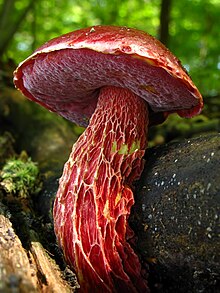| Exsudoporus frostii | |
|---|---|

| |
| Scientific classification | |
| Domain: | Eukaryota |
| Kingdom: | Fungi |
| Division: | Basidiomycota |
| Class: | Agaricomycetes |
| Order: | Boletales |
| Family: | Boletaceae |
| Genus: | Exsudoporus |
| Species: | E. frostii
|
| Binomial name | |
| Exsudoporus frostii (J.L.Russell) Vizzini, Simonini & Gelardi (2014)
| |
| Synonyms[1] | |
| Exsudoporus frostii | |
|---|---|
| Pores on hymenium | |
| Cap is convex or flat | |
| Hymenium is adnate | |
| Stipe is bare | |
| Spore print is olive-brown | |
| Ecology is mycorrhizal | |
| Edibility is edible | |
Exsudoporus frostii (formerly Boletus frostii), commonly known as Frost's bolete or the apple bolete, is a bolete fungus first described scientifically in 1874. A member of the family Boletaceae, the mushrooms produced by the fungus have tubes and pores instead of gills on the underside of their caps. Exsudoporus frostii is distributed in the eastern United States from Maine to Georgia, and in the southwest from Arizona extending south to Mexico and Costa Rica. A mycorrhizal species, its fruit bodies are typically found growing near hardwood trees, especially oak.
Exsudoporus frostii mushrooms can be recognized by their dark red sticky caps, the red pores, the network-like pattern of the stipe, and the bluing reaction to tissue injury. Another characteristic of young, moist fruit bodies is the amber-colored drops exuded on the pore surface. Although this mushroom is considered edible when thoroughly cooked, it is generally not recommended for consumption because of the risk of confusion with other poisonous red-pored, blue-bruising boletes. B. frostii may be distinguished from other superficially similar red-capped boletes by differences in distribution, associated tree species, bluing reaction, or morphology.